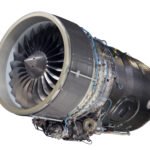B-52 Stratofortress
WASHINGTON: The race for the Air Force’s program to replace the aging engines on the B-52 bomber kicks into high gear on today, with the closing of the window for the three contestants to submit formal proposals. The much-upgraded, 68-year-old Stratofortress remains the mainstay of the much-diminished US bomber fleet, making its continued functioning a strategic imperative.
Pratt & Whitney, GE Aviation, and Rolls Royce last year were granted contracts by the Air Force last year to develop digital engine designs. They also participated in a study with prime contractor Boeing that allowed them to understand how to integrate the new engine into the venerable and much-upgraded airframe.
“There was a study done last year where we got in deep, taking a hard look with Boeing at what it’s going to take to integrate the new engines into the B-52,” Chris Johnson, vice president, Fighter and Mobility Programs at Pratt & Whitney Military Engines, told Breaking D in an interview last week.
Pratt & Whitney’s TF33 currently powers the Air Force’s fleet of 76 operational B-52s, with eight of the engines equipping each aircraft. Indeed, on its website, the firm boasts: “We’ve powered the B-52 since its first flight, and we know exactly what it takes to operate at peak performance.”

Pratt & Whitney PW800 engine
The Air Force issued a request for proposals (RFP) on May 19 for the B-52 Commercial Engine Replacement Program (CERP), with the planned buy covering 608 new engines, spares and services. The service is planning to keep the venerable B-52, which made its first flight in 1952, operating until 2050. The hope is that by using modern commercial engines, the service can reduce costs via lower fuel burn rates and fewer maintenance hours.
While the Air Force specifically is seeking engines that will not need any major overhauls during the Stratofortress’s planned lifetime, the RFP explains that the re-engining contract will include “per event, over and above contract line items” to deal with “unscheduled repairs,” an inevitability for military aircraft.
Johnson said Pratt & Whitney is offering the PW800 engine, which is already in service in commercial aircraft including the Gulf Stream 500/600 series business jets. The PW800 received its FAA certification in February 2017. That would allow the Air Force to benefit from “a warm supply chain” and existing maintenance and repair facilities.
Pratt & Whitney’s website, on a page dedicated to the B-52 contest, touts “significantly lower sustainment costs” along with “increased power” and “improved fuel efficiency” as among the PW800s features.

GE Aviation’s Passport engine
GE Aviation, meanwhile, argues in a white paper provided to Breaking Defense that it “has successfully completed more aircraft re-enginings for the U.S. Air Force than any other company.” The firm, which further notes that its engines have powered six strategic bombers, is offering not one, but two, options for the B-52 CERP, both of them already in service: the CF34-10 and the Passport.
According to GE Aviation’s website on its B-52 offering, the CF34-10 has some 31 million flight hours, with more than 1,600 engines in use. Passport, which had its first flight in 2015, “recently powered the longest non-stop business jet flight in history (8,152 nm), a testament to its endurance,” the website boasts.
Rolls Royce is offering the F130 engine, which is “already powering both the C-37 and E-11 BACN aircraft,” according to the firm’s website.The F130 is based on the Rolls Royce BR700 family of business jet engines, with the company says have clocked more than 25 million flight hours on both civil and military aircraft.

Rolls Royce F130
The Air Force’s RFP does not include the planned costs of the CERP effort. It does show that the contract is expected to be granted in the last quarter of 2021, with production to start in the second quarter of 2027.
The overall performance period for the winning contractor is 17 years. The RFP states:
“Initial engine quantities include 16-64 engines to integrate onto prototype aircraft, plus additional spares. The remaining quantity of engines will be acquired over the course of multiple ordering periods, for a total contemplated period of performance of up to 17 years. The 17 year period of performance includes a basic period and option periods as follows: one six-year basic period, one five-year option, and six one-year options.”














